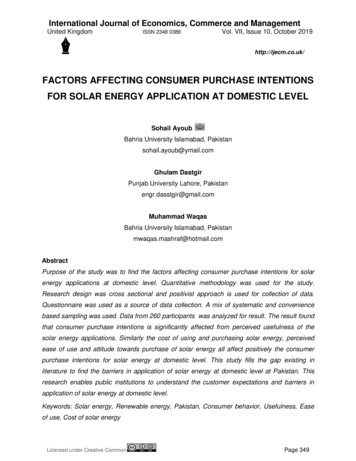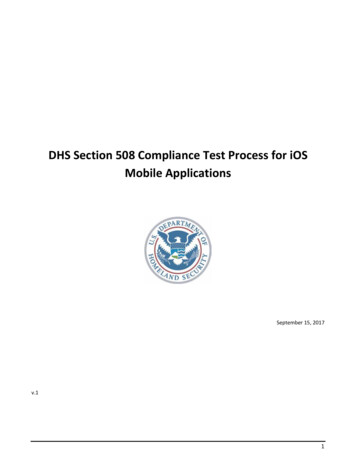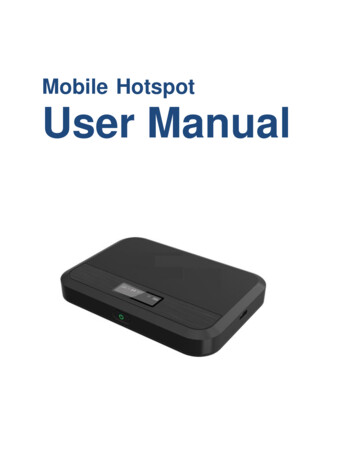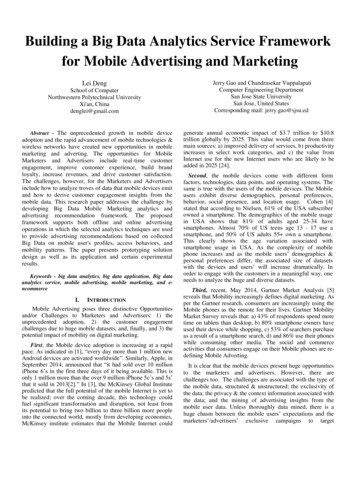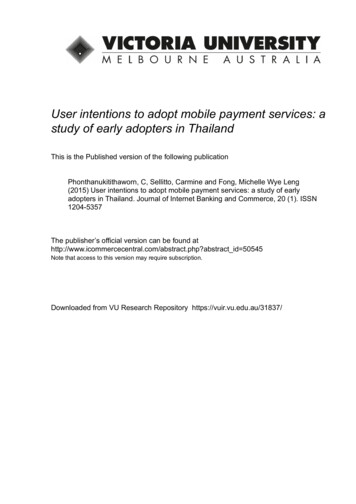
Transcription
User intentions to adopt mobile payment services: astudy of early adopters in ThailandThis is the Published version of the following publicationPhonthanukitithaworn, C, Sellitto, Carmine and Fong, Michelle Wye Leng(2015) User intentions to adopt mobile payment services: a study of earlyadopters in Thailand. Journal of Internet Banking and Commerce, 20 (1). ISSN1204-5357The publisher’s official version can be found tract id 50545Note that access to this version may require subscription.Downloaded from VU Research Repository https://vuir.vu.edu.au/31837/
Journal of Internet Banking and CommerceAn open access Internet journal (http://www.arraydev.com/commerce/jibc/)Journal of Internet Banking and Commerce, April 2015, vol. 20, no. 1(http://www.arraydev.com/commerce/jibc/)User Intentions to Adopt Mobile Payment Services: A Study ofEarly Adopters in ThailandCHANCHAI PHONTHANUKITITHAWORN, D.B.ALecturer, Business Administration Division, Mahidol University InternationalCollege, Nakhon Pathom, ThailandPostal Address: 999 Phutthamonthon 4 Road, Salaya, Phutthamonthon, NakonPathom 73170, ThailandEmail: chanchai.pho@mahidol.ac.thChanchai Phonthanukitithaworn is a lecturer in the business administration division atMahidol University International College. His research interests include innovationadoption, mobile payment technologies, mobile commerce, consumer behavior, andcross-cultural research on technology adoption.CARMINE SELLITTO, PhDSenior Lecturer, College of Business, Victoria University, Melbourne, AustraliaPostal Address: PO Box 14428 Melbourne VIC 8001 AustraliaEmail: carmine.sellitto@vu.edu.auCarmine Sellitto is an academic at Victoria University in the Information Systemsdiscipline. He is also affiliated as a research associate with the Centre for AppliedInformatics, as well as the Institute for Sport, Exercise Science and Active Living(ISEAL). Dr. Sellitto has published widely and some of his 100 peer-reviewedpublications have been on topics associated with education and learning, managementand technology, tourism and IT, e-business & Internet-marketing, information quality andsmall business technology adoption.MICHELLE FONG, PhDSenior Lecturer, College of Business, Victoria University, Melbourne, AustraliaPostal Address: PO Box 14428 Melbourne VIC 8001 AustraliaEmail: michelle.fong@vu.edu.auMichelle Fong is a senior lecturer in the finance and financial service discipline in theCollege of Business at Victoria University. Prior to Dr. Fong’s academic and researchcareer, she worked in finance and marketing fields. Her research interests include
JIBC April 2015, Vol. 20, No. 1-2-banking payment systems, business analysis, information technology applications and emarketing. She has published widely in journals, book chapters and conferenceproceedingsAbstractThe adoption and use of M-payment services has become critical for entities involved inthe mobile commerce industry in Asian countries. This paper reports on research thatinvestigated the factors affecting consumer intentions to adopt mobile payment (Mpayment) services in Thailand. The study developed a model based on an extendedversion of the technology acceptance model (TAM) that was modified using constructsthat were explained in terms of Hofstede’s cultural dimensions allowing the findings to bereported in context using the Thai national setting. Arguably, the alignment of culturaldimensions with the extended TAM constructs is one that distinguishes the contributionof the paper from previous studies. Responses from 256 early adopters of M-paymentservices were empirically analyzed using structural equation modelling (SEM) to test aset of research hypotheses. The results indicate that consumer adoption of M-paymentservices in Thailand was determined by four factors—compatibility, subjective norm,perceived trust, and perceived cost. Surprisingly, the construct of perceived risk and thetwo major TAM constructs—perceived usefulness (PU) and perceived ease of use(PEOU) were found not to have a direct effect on behavioral intention.Keywords: Mobile payment services, behavioral intention, TAM, structural equationmodelling, cultural dimensions Chanchai Phonthanukitithaworn, Carmine Sellitto, Michelle Fong, 2015INTRODUCTIONAs the use of mobile phone technology has become increasingly common in everydaylife, there has also been a rapid expansion of services using mobile phone technology asthe primary delivery platform. M -payment is one such service that allows mobile phoneowners to easily and conveniently undertakes payments and transfer funds using theirphones. The transaction conducted through this channel is charged in different ways,such as monthly mobile subscription bills, debit or credit card, separate M-paymentaccount or deducted from prepaid airtime or bank accounts (Mallat et al., 2004).M-payment services cover different types of payment, such as downloaded digital mobilecontent services (e.g. games, music, news, logos, ringtones, and mobile applications),fares for taxis, trains or buses, parking fees, and tickets for flights, movies or concerts.Indeed, M-payment services have received a great amount of attention from the bankingindustry given the recent advent of the internet-enabled smart phone as a ubiquitouscommunication item (Zhang & Dodgson, 2007). Global technology research firm Gartner(2012) predicts that the gross value of transactions conducted through some form of Mpayment service will reach over USD730 billion by 2016. Arguably, the predictedexpansion of M-payment services provides a convincing argument for stakeholders toinvest and expand the use of such a service.
JIBC April 2015, Vol. 20, No. 1-3-M-payment services offer significant cost-benefit advantages for consumers, businessgroups and national governments over traditional cash and/or financial cardtransactions. However, Thailand, where there is a high rate of mobile phone adoption,M-payment services have not reached a critical stage of diffusion— even thoughsignificant benefits would result. Furthermore, significant resources have been investedin building and developing an M-payment infrastructure so as to provide opportunities forThai consumers to use their mobile devices to conduct everyday financial transactions(Bank of Thailand, 2012). Given this investment regime, relatively low M-paymentadoption rates have been noted. Indeed, the National Statistical Office (2013) reportsthat a relatively small proportion of the 44.1 million Thai mobile phone users conductfinancial transactions using a mobile device.It is unclear as to why M-payment services have lagged behind the relatively high mobilephone use in Thailand given the significant advantages M-payment services bring interms of convenience and flexibility, especially for people who have no internetconnection (Lim, 2008). M-payment services have been available in the market for quitea number of years; however, they have not been able to gain high market share orgenerate interest among the Thai public. The reason for this relatively low adoption of Mpayment services is not clear and needs to be ascertained.Several studies have advanced the theory that consumer behavior plays an importantrole in the adoption of new payment systems, particularly electronic payment modeswhere consumer attitudes towards the adoption of new payment systems have beenrecorded as an important issue (D' Silva, 2009; Dahlberg et al., 2008; Evans &Schmalensee, 2009; Litan & Baily, 2009; Zhang & Dodgson, 2007). Noting the mismatchbetween Thai government investment and low consumer adoption of M-paymentservices, this paper develops and subsequently tests a theoretical model thatencapsulates consumer intentions to adopt M-payment services within a Thai context.The research model for this study was formulated on the basis of the well-documentedtechnology acceptance model (TAM). However, in light of suggestions made by previousstudies (Kim & Garrison, 2009; Sun et al., 2009; Zarmpou et al., 2012), the TAM wasmodified by incorporating relevant construct that have an influence on a consumer’sintention to adopt M-payment services. Hofstede’s (Hofstede & Hofstede, 2005)framework that documented the cultural dimensions for Thailand was used to argue thatthe model’s constructs also reflected cultural characteristics in the Thai setting.Accordingly, the research model for this study consisted of two major constructs(perceived usefulness and perceived ease of use) associated with traditional TAM andfive additional constructs (compatibility, subjective norm, perceived trust, perceived risk,and perceived cost). These constructs were theoretically justified to have a direct effecton people’s behavioral intention to adopt M-payment services. The alignment of culturaldimensions to the constructs used in this study is a distinguishing contribution of thepaper when compared to previous publications on TAM. Previous studies, such as thatof McCoy et al. (2007) and Teo et al. (2008) have examined TAM’s fundamentalconstructs of PU and PEOU in regards to national cultural however, such studies do notinclude additional and relevant constructs that are argued as reflecting components ofculture.The outcomes of this study are expected to contribute to theoretical and practical
JIBC April 2015, Vol. 20, No. 1-4-knowledge about M-payment services adoption. From a theoretical perspective, wemodified traditional TAM by incorporating additional constructs which reflect Thai culturalcharacteristics and technology adoption. Therefore, the research model proposed in thepaper can potentially be applied to other societies that are culturally similar to Thailandin predicting the adoption of new or emerging technologies. From a practicalperspective, the research is informative for the Thai M-payment services industry—particularly mobile network operators (MNOs), financial institutions, and payment serviceproviders. The results can be used to assist entities in the M-payment industry toimplement appropriate service strategies and design suitable business models toimprove the uptake of M-payment services.The remainder of this paper is organized as follows. Section 2 includes a literaturereview followed by a presentation of the research hypotheses and the conceptualframework in section 3. The research methods and results of data analysis arepresented in sections 4 and 5. Section 6 provides the discussion of these resultsfollowed by the theoretical and managerial implications and the limitations of this study.LITERATURE REVIEWVarious innovation adoption theories have frequently been applied in research studies topredict an individual’s intention to adopt recent innovations and/or technologies. Thesetheories included innovation diffusion theory (IDT), the theory of reasoned action (TRA),the theory of planned behavior (TPB), and the technology acceptance model (TAM). IDTexplains the likelihood and the rate of an innovation being adopted by examining theprocess by which innovation is communicated through certain channels over time amongthe members of a social system (Rogers, 2003). The theory highlights the importance ofthe innovation decision process, the determinants of adoption, and that there are variouscategories of adopters.The TRA was proposed by Fishbein and Ajzen (1975) and it suggests that a person’sactual behavior is determined by his/her behavioral intentions to perform a particularactivity. Behavioral intention is shaped and influenced by the individual’s attitude andsubjective norms, which are in turn shaped by their beliefs associated with motivationsand the evaluation of beliefs. TRA was later extended to the TPB by adding an additionalvariable to the model, namely, perceived behavioral control in order to reflect theparameter of control beliefs that relate to one’s abilities, situation, and resources (Ajzen,1991). Finally, the TAM indicates that the two individual beliefs—perceived usefulness(PU) and perceived ease of use (PEOU) are the major determinants influencing anindividual’s behavioral intentions and actual behavior when considering new technology(Davis, 1989).Comparisons between innovation adoption theories show that TAM appears to havegreater advantages over TPB and IDT as a simpler, easier-to-apply model with greaterefficiency in predicting and explaining an individual’s adoption intentions and actualbehavior. Many studies used to investigate M-payment services adoption have adoptedTAM over other theories because it has been shown to allow a causal validation ofvariables (Chandra et al., 2010; Chen, 2008; Kim et al., 2010; Schierz et al., 2010; Yanet al., 2009; Zhou, 2011). Even though TAM has been found to be a parsimonious model
JIBC April 2015, Vol. 20, No. 1-5-(Venkatesh & Davis, 2000), its ease of applicability and simplicity, as well as anynegative consequence of its conceptualization can be rectified by incorporatingadditional constructs to increase its predictive power (Shin, 2010). Many empiricalstudies on the M-payment services adoption have used various forms of extended TAMmodels to amplify its predictive and explanatory power and authors recommend thisapproach in future mobile technology studies (Chen, 2008; Kim et al., 2010; Shin, 2010).Therefore, based on the inherent superiority of TAM, as well as the recommendations ofpast studies, this study modified the TAM model by maintaining the major constructs ofPU, PEOU, and behavioral intention—whilst extending the model with other relevantconstructs.EXTENDED TAM AND ISSUES ASSOCIATED WITH THAI CULTURE ANDTECHNOLOGY ADOPTIONAccording to the review of previous studies on M-payment services adoption (Chandraet al., 2010; Chen, 2008; Goeke & Pousttchi, 2010; Keramati et al., 2011; Kim et al.,2010; Peng et al., 2012; Schierz et al., 2010; Shin, 2010; Yan et al., 2009; Zhou, 2011),there are a number of possible constructs that can be employed in this study.However, in most instances the constructs are not aligned with the culturalcharacteristics of the country where they are conducted and which may potentially affectoutcomes. This is supported by Smith et al. (2011) who observed that transnationalstudies commonly adopt frameworks that have been based on Western research, whichare then applied to a culturally different setting. Chau et al. (2002) suggest that thecultural environment in different countries may influence the way people behave andplays a significant role in the way people use technology. This notion is consistent toMallat (2007) who noted that the adoption of M-payment services in different countriescould depend on cultural differences and market conditions. For instance, Japan andKorea are both widely recognized as global leaders and users of digital technology andM-payment services. People from these countries may perceived technology to be moreuseful and easy to use than people from countries where technology is underdeveloped(Zhang & Dodgson, 2007). As a result, the extended TAM used in this study took intoaccount cultural aspects of the Thai society using Hofstede’s cultural dimensions(Hofstede & Hofstede, 2005) as a guideline to inform relevant additional constructsspecific to Thai cultural settings in an endeavor to align them to factors that may have animpact on the use of M-payment in Thailand. Although several cultural frameworks havebeen proposed in the literature, Hofstede’s (Hofstede & Hofstede, 2005) frameworkelaborating different dimensions of culture is of particular interest to this study becausethe framework has been frequently used and validated, generally in a variety ofmanagement research projects (Myers & Tan, 2002), as well as in informationtechnology research (Steenkamp, 2001).Hofstede’s (Hofstede & Hofstede, 2005) five dimensions have been shown to beapplicable to different features that can distinguish national culture. These dimensionsinclude a power distance index (PDI), individualism versus collectivism (IDV), thecountry’s uncertainty avoidance index (UAI), masculinity vs femininity (MAS), andwhether a culture has a long-term orientation (LTO) that values plans for futureoutcomes. Many national scores for each cultural dimension have been calculated byHofstede and Hofstede (2005) that also include those relating to Thailand. In respect of
JIBC April 2015, Vol. 20, No. 1-6-these cultural dimension scores—Thai society is noted as being characterized as havinga relatively high power distance index (score 64), high long-term orientation (score 56),and a high uncertainty avoidance index (score 64). Thai society, on the other hand, hasscored relatively low with respect to individualism (score 20) and masculinity (score 34).Power distance is defined as ‘the extent to which the less powerful members ofinstitutions and organizations within a country expect and accept that power isdistributed unequally’ (Hofstede & Hofstede, 2005) p. 46. In other words, this dimensionrefers to the extent to which a member of a society passively accepts that the powercontrolled and authorized in institutions is distributed equally among individuals in thesociety. In societies with a high power distance index, such as Thailand, status andauthority are very important. As a high power distance society, Thais may be morewilling to accept a technology when they are directed to do so, since they are inclined toshow respect for authority and conform to the expectations of superiors. Gong et al.(2007) found that individuals in societies with a high power distance index tended toshow less initiative in considering and discussing the introduction of new products andtechnologies. Individuals in high power distance societies generally wait for signals fromauthority figures or opinion leaders. Given that authority plays a key role in high powerdistance cultures, people are likely to follow the behavior of their leaders and adopt newproducts or services when they see their superiors adopting these entities. This notion isparallel to the concept of subjective norm that is defined as ‘the person’s perception thatmost people who are important to him think he should or should not perform thebehavior in question’ (Fishbein & Ajzen, 1975, p. 302) p. 302. Jaruwachirathanakul andFink (2005) employed subjective norm as a cultural factor, and suggested this constructcould be used to assess adoption of new technology in cultures that have a high powerdistance index.Individualism prevails in ‘societies in which the ties between individuals are loose:everyone is expected to look after himself or herself and his or her immediate family’(Hofstede & Hofstede, 2005) p. 76. On the other hand, collectivism is the feature of‘societies in which people from birth onward are integrated into strong, cohesive ingroups, which throughout people’s lifetimes continue to protect them in exchange forunquestioning loyalty’ (Hofstede & Hofstede, 2005) p. 76. In other words, collectivistcultures emphasize qualities such as loyalty, solidarity, interdependence, conflictavoidance, and identification with others that form part of a group. Thai society has a lowscore when it comes to individualism in Hofstede’s framework, with investigationsshowing that Thailand is a collectivist instead of individualist society. Severalresearchers, such as Lee and Green (1991), state that collectivist culture is also relatedto the notion of subjective norm. Subjective norm implies that people’s opinions play animportant role in affecting an individual’s behavior. In collectivist cultures, such asThailand, an individual is inclined to adopt an idea, product or technology if his/her widergroup or society also adopts the idea, product or technology. Arguably, people are morelikely to adopt new technology when the whole group decides that it is a good idea.People in collectivist societies tend to build and maintain relationships with people withintheir social structure or group; therefore, the level of communication among themembers of these societies is likely to be higher (Mooij, 2004). This implies that there isa parallel between collectivist culture and the construct of subjective norm.
JIBC April 2015, Vol. 20, No. 1-7-Masculinity/femininity refers to the extent to which the general disposition of individualsin a society is characterized by assertiveness, nurturance and the extent to which theyadhere to societal expectations of gender roles. Hofstede and Hofstede (2005) p. 120explain that ‘A society is called masculine when emotional gender roles are clearlydistinct: men are supposed to be assertive, tough, and focused on material success,whereas women are supposed to be more modest, tender, and concerned with thequality of life’, whereas ‘A society is called feminine when emotional gender rolesoverlap: both men and women are supposed to be modest, tender, and concerned withthe quality of life’. Masculine cultures value achievement, heroism, assertiveness, andmaterial success and follow rigid gender norms, while feminine cultures valuerelationships, caring, preserving the environment, equality, and are not structuredaround rigid gender roles. According to Hofstede and Hofstede (2005), Thailand can becategorized as a feminine culture. This implies that Thais value relationships, caring,preserving the environment, and equality to others and tend to be service-oriented andhave a strong people orientation. Jaruwachirathanakul and Fink (2005) suggest thatpersonal relationships and face-to-face conversations are important in the Thai culture.They further observe that personal interaction when conducting a banking transaction inThailand is considered as value-addition to customer service. This is consistent with anotion advanced by Sammapan (1996) that Thais prefer informal and personalrelationship-based communication. But the strong human orientation in Thai society maypossibly make the self-service approach of electronic financial services somewhatunattractive. Since M-payment services tend to reduce physical interaction and arebased on a self-service mode of operation, Thai people may find this type of paymentinconsistent with their customary behavior and lifestyle. Arguably, Thais might findpayment modes with face-to-face interaction such as counter services, or humancommunication such as telephone banking more compatible than the anonymous selfservice mode of M-payment services. From another point of view, themasculine/feminine characterization of a society may also be related to the concept ofcompatibility encountered in innovation diffusion theory by Rogers (2003). Compatibilityreflects the degree to which the adopters perceive that an innovation is consistent withtheir requirements—requirements that are shaped by their values, beliefs, pastexperiences and habits. These inherent individual requirements associated withcompatibility are also apparent in masculine or feminine orientations of a culture thatdirect certain future behaviors based on established lifestyles and values.Uncertainty avoidance is defined as ‘the extent to which the members of a culture feelthreatened by ambiguous or unknown situations’ (Hofstede & Hofstede, 2005) p. 167. Aculture with a low uncertainty avoidance index exhibits greater tolerance for risk withpeople in such societies being more innovative, entrepreneurial and more willing to trynew things (Hofstede & Hofstede, 2005). On the other hand, countries such as Thailandexhibit high uncertainty avoidance value security, clear rules, and a formality to thestructure of life. Hence, Thai citizens can be viewed as being generally more resistant tochange from established behavioral patterns and tend to focus on risk avoidance andreduction. Due to high uncertainty avoidance in Thai society, M-payment services couldbe seemingly regarded by Thais as a high-risk payment method when compared totraditional face-to-face payments. Indeed, money, products and recipients are not part ofM-payment transactions— hence, Thais may feel insecure about this scenario andbecome reluctant to change from using their existing payment methods. Thisenvironment of uncertainty avoidance can also be argued as being related to the
JIBC April 2015, Vol. 20, No. 1-8-construct of perceived risk. Perceived risk is explained as the feeling of uncertaintyregarding possible negative consequences of using a product or service (Bauer, 1967).According to Featherman and Pavlou (2003), perceived risk is related to perceived trustand together these constructs can reflect how the level of risk increases or decreaseswhen a person trusts other parties involved in a transaction. Trust appears to be animportant determinant that overcomes personal fears associated with risk anduncertainty. In e-commerce studies, trust is explained as the subjective probability withwhich consumers believe that a particular transaction will occur in a manner consistentwith their expectations (Chellappa & Pavlou, 2002). If an individual senses a lack oftrust, they may refuse to give their personal information such as a telephone number orcredit card number to banks, mobile service providers or third parties involved in thetransaction. Hence, perceived risk and perceived trust are proposed as importantdeterminants in the adoption of electronic payment systems. For instance, Mallat (2007)suggests that perceived trust positively influences a consumer’s intention to use Mpayment services. Similarly, Schierz et al. (2010) indicate that consumers are lessmotivated to adopt new payment methods when they perceive that the risk of adoptingthem is greater than using existing methods. Arguably, the issues of perceived risk andperceived trust in the adoption of M-payment services will be associated with societalexpectations encountered in a high UAI culture, as exists in Thailand. High UAI culturestry to avoid ambiguous situations and are rule-orientated, directing people to behave in aparticular manner. High UAI cultures are also change resistant, people being traditionalin their outlook, with change being associated with risk—risk avoidance being a featureof such cultures (Hofstede & Hofstede, 2005). In Thai society, perceived risk andperceived trust of new payment services will invariably be influenced by these high UAIfeatures of risk avoidance, opposition to change and traditional rules that governfinancial payment behavior.Long-term/short-term orientation refers to the attitudes and beliefs held by people ofdifferent cultural groups with regard to the future, and this determines how they act. AsHofstede and Hofstede (2005) p. 210 explain, long-term orientation shows ‘the fosteringof virtues oriented toward future rewards—in particular, perseverance and thrift’whereas, short-term orientation emphasizes ‘the fostering of virtues related to the pastand present—in particular, respect for tradition, preservation of “face”, and fulfilling socialobligations’. Thailand is a long-term orientation culture where Thais tend to emphasizethrift and saving for the future and prefer investment in projects with long-term benefit(Hofstede & Hofstede, 2005). Hofstede (1993) also found that individuals who value thriftalso tend to be cost-conscious. Similarly, in their study on household technologyadoption in a global marketplace, Zhang and Maruping (2008) noted that peopleassociated with LTO cultures had a preference for future planning and cost saving. Theirstudy also suggests that people in this type of culture not only seek information aboutnew technology for present needs, but also want to know about its future potential,longevity and continued relevance. By focusing on the future, people were found to wantto learn about the longevity of the technology, as well as its value for money. Zhang andMaruping (2008) also noted that if the life cycle of a new technology is short, or thecurrent price is expensive and expected to fall in the short term, this will negativelyinfluence their intention to buy the product. From this perspective, it can be seen that theissue of the cost of acquiring technology is associated with an individual’s behavioralintention to adopt the technology in LTO cultures. Incorporating this insight into thecontext of M-payment adoption in Thailand, it can be asserted that a new payment
JIBC April 2015, Vol. 20, No. 1-9-system, such as M-payment, with little history of use or adoption, is likely to be viewedwith caution by Thais. Arguably, Thais would be potentially hesitant about the costassociated with using M-payment services, as well as signing up for such a service. Asnoted earlier, M-payment services are accompanied by additional costs associated witha transaction fee, a new headset and access or subscription fees (Luarn & Lin, 2005).Belonging to an LTO culture, Thais may find M-payment services to be an unattractiveand unnecessary option, if there are additional costs involved or the benefits of using Mpayment services do not offer personal value. This notion is consistent with someempirical studies conducted in Asian countries on the issue. In their study on mobilebanking in Taiwan, Luarn and Lin (2005) found that perceived cost, or the extent towhich an individual believes that using a service will incur extra costs, can act as a factorinhibiting consumer decision-making. In Malaysia, Wei et al. (2009) also found thatperceived cost was a barrier to the adoption of m-commerce in the country. Cheong andPark (2005) also found perceived cost to be an influential factor in predicting thebehavioral intention of customers using m-commerce in Korea. They suggest extendingthe theoretical model of TAM by incorporating the construct of perceived cost. Given theoverwhelming evidence in the empirical research and the categorization of Thailand as acost-conscious LTO culture, perceived cost is a justified construct that can be used tomeasure behavioral intention to adoption M-payment services in Thailand.In summary, this study modified the TAM mo
College, Nakhon Pathom, Thailand Postal Address: 999 Phutthamonthon 4 Road, Salaya, Phutthamonthon, Nakon Pathom 73170, Thailand Email: chanchai.pho@mahidol.ac.th Chanchai Phonthanukitithaworn is a lecturer in the business administration division at Mahidol University International College. His research interests include innovation
